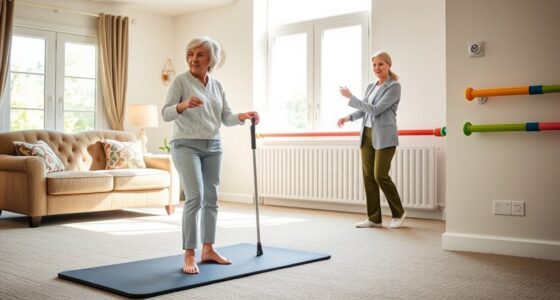After loss, caring for yourself is essential to heal and rebuild resilience. Recognize the signs of burnout, such as exhaustion, irritability, or difficulty focusing. Set clear boundaries, prioritize sleep, nutritious meals, and gentle exercise. Reach out to support networks and practice mindfulness to reduce stress. Consistently develop a personalized self-care plan that includes physical, emotional, and spiritual practices. Continuing your journey can help you rebuild your strength and find renewed hope and balance.
Key Takeaways
- Prioritize self-awareness to recognize emotional exhaustion and seek support early.
- Establish boundaries and schedule regular self-care activities to prevent burnout.
- Build supportive networks and engage in community for emotional reassurance and practical help.
- Incorporate stress-relief techniques like deep breathing, mindfulness, and physical activity into daily routines.
- Develop a long-term self-care plan that adapts to changing needs, fostering resilience and emotional recovery.
Recognizing the Signs of Caregiver Burnout

How can you tell if you’re experiencing caregiver burnout? You might notice feelings of overwhelming exhaustion, both physically and emotionally. You could feel irritable or impatient more often than usual, even with people close to you. Sleep might become disrupted, or you might find it hard to focus on daily tasks. You may begin neglecting your own needs, skipping meals, or avoiding exercise. A sense of hopelessness or feeling trapped in your role can also surface. If you notice these signs persisting, it’s a clear warning that you’re nearing burnout. Recognizing these early symptoms helps you take steps before exhaustion takes a serious toll on your health. Paying attention to your feelings and physical state is essential for maintaining your well-being. Being aware of your physical and emotional health can help you identify warning signs early and seek support when needed. Additionally, understanding essential oils for self-care can offer calming relief and support your recovery during stressful times.
The Emotional Impact of Loss on Caregivers

Caring for a loved one often involves facing profound feelings of loss, which can strike unexpectedly and deeply impact your emotional well-being. You might feel sadness, anger, or guilt, sometimes all at once. These emotions can be overwhelming and confusing, leaving you drained or numb. Recognizing that loss affects everyone differently is important. It’s normal to experience a range of reactions, from grief to relief. Being aware of emotional responses can help you better understand and manage your feelings. Understanding grief and its stages can provide comfort and clarity during difficult times.
Establishing Boundaries to Protect Your Well-Being

Setting boundaries starts with knowing your personal limits and honoring them. Be clear and direct when communicating what you can and cannot do. Doing so protects your well-being and helps maintain a sustainable caregiving routine. Incorporating stress management techniques can further support your emotional resilience during challenging times. Remember that engaging in mindfulness practices can help you stay present and centered, reducing feelings of overwhelm.
Recognize Personal Limits
Recognizing your personal limits is essential for maintaining your well-being as a caregiver. You need to understand what you can handle physically, emotionally, and mentally. Pay attention to signs of exhaustion, frustration, or feeling overwhelmed—these indicate you may be pushing beyond your capacity. Setting realistic expectations helps prevent burnout and preserves your energy. It’s important to accept that you can’t do everything and to prioritize your needs alongside those you care for. Establishing your limits isn’t selfish; it’s a necessary step to stay healthy and effective. Regularly check in with yourself to gauge your stress levels and adjust your commitments accordingly. By recognizing and respecting your limits, you create a sustainable caregiving approach that protects your long-term well-being.
Communicate Needs Clearly
Effective communication is key to establishing boundaries that protect your well-being as a caregiver. When you clearly express your needs, others understand your limits and respect your space. Be specific about what you can and cannot do, and don’t hesitate to say no when necessary. Practice honest, direct conversations to avoid misunderstandings and ensure your feelings are heard. Remember, setting boundaries isn’t about being unhelpful—it’s about safeguarding your mental and emotional health.
- Use simple language to convey your needs without ambiguity
- Stay calm and assertive, even when difficult topics arise
- Repeat your boundaries if they’re challenged or ignored
- Prioritize your well-being over guilt or obligation
- Recognize that clear communication fosters respect and understanding
Practical Self-Care Strategies for Healing

When you’re caring for others, it’s vital to prioritize your own healing by adopting practical self-care strategies. First, set aside regular time for rest, ensuring you get enough sleep and downtime to recharge. Incorporate physical activity into your routine, whether it’s walking, stretching, or yoga, to boost your mood and energy. Nourish your body with balanced, nutritious meals, and stay hydrated. Practice mindfulness or meditation to manage stress and stay grounded. Make space for hobbies or activities that bring you joy, helping to restore your emotional well-being. Finally, establish boundaries by learning to say no when necessary, preventing burnout. These simple, consistent actions can greatly enhance your resilience and promote healing as you continue your caregiving journey. Considering your dog’s names can also bring comfort and companionship during challenging times.
The Role of Support Systems and Community

Have you considered how a strong support system can make a difference in your caregiving journey? When you lean on others, you gain emotional strength, practical help, and reassurance. Connecting with community groups, friends, or support networks reminds you you’re not alone, reducing feelings of isolation. These connections can provide guidance, validation, and shared experiences that help you navigate tough times. Remember, building a support system isn’t just about assistance—it’s about creating a safety net that nurtures your well-being. Support network can serve as a foundation for emotional resilience and practical aid. Cultivating peer support offers additional comfort and shared understanding, further strengthening your emotional well-being. Nurturing these relationships allows you to recharge and maintain resilience. Additionally, understanding the importance of self-care routines can help caregivers focus on self-care routines more mindfully, enhancing their overall well-being.
Incorporating Mindfulness and Stress Reduction Techniques

Incorporating mindfulness and stress reduction techniques can substantially improve your well-being as a caregiver. You can use simple practices like deep breathing or focused meditation to manage daily stress. These tools not only help you stay centered but also support your overall healing and resilience.
Mindfulness Practices for Caregivers
Practicing mindfulness can be a powerful way for caregivers to manage stress and stay present in challenging moments. It helps you acknowledge your feelings without judgment and creates space for calmness amid chaos. Incorporate simple techniques to deepen your practice:
- Focus on your breath, inhaling slowly and exhaling fully to anchor yourself.
- Engage in body scans to notice tension and release it intentionally.
- Use mindful listening to connect fully during conversations.
- Take brief pauses throughout your day to reset your mind.
- Practice gratitude to shift your perspective and foster positivity.
These practices cultivate awareness, reduce overwhelm, and build resilience. By dedicating a few moments each day, you nurture your mental well-being, enabling you to better support your loved ones while caring for yourself.
Stress-Relief Techniques for Healing
Building on mindfulness practices, integrating specific stress-relief techniques can substantially enhance your healing process. Deep breathing exercises, like diaphragmatic breathing, help calm your nervous system and reduce immediate stress. Progressive muscle relaxation releases tension stored in your body, promoting physical and mental ease. Incorporating guided imagery allows you to visualize peaceful settings, providing mental escape during stressful moments. Regular physical activity, even a short walk, boosts endorphin levels and clears your mind. Additionally, setting boundaries and scheduling regular breaks prevent burnout. Remember, these techniques aren’t one-size-fits-all; experiment to find what works best for you. Consistent practice can make these stress-relief strategies an effective part of your self-care routine, helping you heal and regain balance as a caregiver.
Prioritizing Physical Health and Restorative Practices

Prioritizing your physical health is essential to sustain your ability to care for others. When you neglect your body, your energy, resilience, and emotional stability suffer. Incorporate restorative practices that support your well-being, such as regular sleep, balanced nutrition, and gentle movement. Taking time for self-care isn’t selfish—it replenishes your capacity to give. Recognize signs of exhaustion early and address them before burnout sets in. Make space for activities that renew your spirit and promote physical recovery. Remember, your health directly impacts your caregiving.
Prioritize your health with rest, nourishing foods, and gentle movement to sustain your caregiving capacity.
- Listen to your body’s signals and respond promptly
- Establish consistent sleep routines to restore energy
- Nourish yourself with wholesome, nourishing foods
- Engage in gentle physical activity to boost circulation
- Create moments of stillness to reconnect and recharge
Rebuilding Resilience Through Personal Growth

When you actively seek opportunities for personal growth, you strengthen your ability to bounce back from challenges and adapt to changes. Embracing new skills, perspectives, or hobbies fosters resilience by expanding your coping toolkit. Reflecting on past experiences helps you identify strengths and areas for improvement, building confidence. Growth also involves setting realistic goals and celebrating progress, which fuels motivation. Consider this table to deepen your understanding:
| Growth Area | Example Activities |
|---|---|
| Emotional Awareness | Journaling, mindfulness meditation |
| Skill Development | Enrolling in courses, learning new hobbies |
| Social Connections | Joining support groups, networking |
| Self-Reflection | Regular check-ins, therapy sessions |
| Goal Setting | Short-term milestones, long-term visions |
Creating a Long-Term Self-Care Plan

Creating a long-term self-care plan guarantees you consistently nurture your well-being and maintain resilience over time. It helps you stay grounded, even during challenging moments, by establishing routines that prioritize your health. To make it effective, identify activities that bring you joy, set boundaries to protect your energy, and schedule regular check-ins with yourself. Incorporating mindfulness practices can also enhance your emotional resilience and self-awareness. Regularly assessing your relationships helps ensure you maintain healthy connections and recognize signs of emotional distancing. Exploring goal setting and reflection techniques can further support your ongoing growth and motivation. Engaging with natural materials in your environment or play can promote grounding and emotional balance. Flexibility is key—you’ll need to adapt your plan as circumstances change. Remember, self-care isn’t a one-time fix; it’s an ongoing commitment. Incorporate habits that promote mental, emotional, and physical health, and don’t hesitate to seek support when needed. Building this plan ensures you’re better equipped to face future stressors with strength and balance. For sustained well-being, consider integrating diverse self-care activities that cater to your holistic health needs.
Frequently Asked Questions
How Can Caregivers Identify Their Unique Self-Care Needs?
To identify your unique self-care needs, start by paying attention to how you feel physically, emotionally, and mentally. Notice what routines or activities boost your energy and which drain you. Reflect on your stress triggers and moments of relief. Experiment with different practices like exercise, meditation, or hobbies, and see what helps you recharge. Regularly check in with yourself to adjust your self-care strategies as your needs evolve.
What Are Early Warning Signs of Emotional Exhaustion?
You might notice emotional exhaustion early if you feel overwhelmed, irritable, or detached from your usual activities. Research suggests that persistent fatigue and declining motivation are common signs, indicating your emotional reserves are running low. You may also experience difficulty sleeping or concentrating. Recognizing these signs promptly helps you address burnout before it worsens, allowing you to seek support or practice self-care to restore your emotional well-being.
How Does Cultural Background Influence Self-Care Practices?
Your cultural background shapes how you view and practice self-care, influencing what activities feel acceptable or meaningful. It guides your beliefs about health, community, and support systems, affecting how you prioritize your well-being. You might rely on traditional remedies, spiritual practices, or community support, which can either enhance or hinder your self-care routines. Understanding these influences helps you develop culturally sensitive strategies to nurture your mental and emotional health.
Can Professional Therapy Assist With Caregiver Grief?
Oh, sure, professional therapy is just the magic pill for caregiver grief—if only grief had a one-size-fits-all solution. In reality, therapy offers a safe space to process emotions, gain clarity, and develop coping strategies. You might find it helps you feel less alone and more understood. While it won’t erase your pain, it can empower you to navigate grief with resilience, one step at a time.
What Are Creative Ways to Incorporate Self-Care Into Daily Routines?
To incorporate self-care into your daily routine, start small with simple, enjoyable activities like stretching, mindful breathing, or short walks. Schedule regular breaks and set boundaries to protect your time. Try journaling your thoughts or practicing gratitude to boost emotional well-being. Use moments between tasks for quick relaxation techniques. Consistency is key; by making these practices habitual, you’ll nurture your mind and body amidst busy caregiving days.
Conclusion
Remember, caring for yourself is like tending a garden—you need to water and nurture your well-being to keep it thriving. After all you’ve been through, prioritize your healing so you can bloom again. Embrace self-care as a crucial part of your journey, not just an afterthought. By tending to your needs, you’ll cultivate resilience and find strength to face each new day with hope and renewal. Your well-being is the foundation of your caregiving journey.









